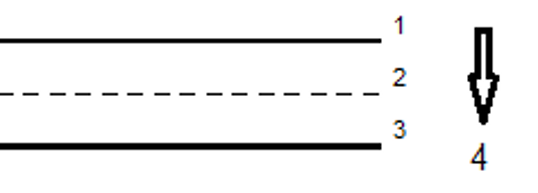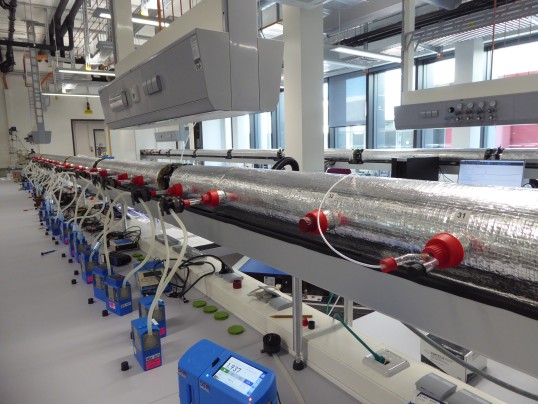- Artificial Intelligence (AI)
- Occupational exposure limit values
- List of CMR substances
- Ergonomics
- EU GHS Regulation
- Industrial Security
- Collaborative robots
- Noise
- Nanoparticles at the workplace
- NoRA OSH standards search tool
- REACH
- Reference materials
- Proficiency testing
- Radiation
- Vibration
- Virtual reality
- Work 4.0
Proficiency testing scheme for inorganic acids
The proficiency testing (PT) is offered alternatively with and without own sampling. Participants may choose whether they wish to perform sampling for inorganic acids themselves, or to have the sample carriers supplied to them [1].
The concentrations to be measured for volatile and non-volatile inorganic acids will lie within the range between 1/10 and twice the AGW1 value [2]. (The German acronym AGW stands for Arbeitsplatzgrenzwert (Occupational Exposure Limit value – OEL). For carcinogenic substances and substances without AGW the database GESTIS - International limit values for chemical agents is used.) Since there is only a short-time limit value for nitric acid, the concentration of one test gas is in accordance with this limit value. The concentrations of the other two test gases are in accordance with the limit value of hydrochloric acid.
For HCl and HNO3, the IFA recommends the analysis method for hazardous substances described in IFA Arbeitsmappe No. 6172 [3], DFG [4] or NIOSH [5]. For H2SO4 and H3PO4, a procedure according to IFA Arbeitsmappe 6173 [6], DFG [7] method or NIOSH [8] is recommended. (Please note: IFA Arbeitsmappe is available in German only.)
Ion chromatography should be employed for analysis.
Proficiency testing scheme with own sampling
A large-scale dynamic test gas stream can be found at the IFA. It is suitable for parallel sampling by up to 25 participants.
- When: 20/21 March 2024
-
Where:
Institut für Arbeitsschutz der Deutschen Gesetzlichen Unfallversicherung (IFA)
Alte Heerstraße 111
53757 Sankt Augustin
Germany - • Concentration range: between 1/10 and two times the AGW value [2]
- Number of test series: 3
- Duration per test series: 2 hours plus preparation time and run-in period (round three will be a short time measurement) (15 min)
- Accommodations: Hotels in Sankt Augustin
In good time, participants will receive detailed information on the PT scheme, a description of the apparatus, and the connections for the sampling devices in particular.
In addition, the participants will receive the sample kit for H2SO4 and H3PO4 (see below).
Covid-19 regulations:
The PT schemes with own sampling are carried out according to the Covid 19 hygiene and behavioural specifications of the DGUV in force at the time of performance. You will be informed in advance about the regulations to be observed.
Proficiency testing without own sampling
The PT for inorganic acids consists of two parts [1]: The same filters are used for volatile and non-volatile acids:
- Quartz fibre filter: MK360, diameter: 37 mm, company: Munktell [3], [6]
Volatile inorganic acids: HCI, HNO3
Loading of the sample carriers for volatile inorganic acids is performed at the dynamic test gas stream of the IFA. Alkaline impregnated* quartz fibre filters are employed as sample carriers.
* Impregnating solution: 1.0 mol/L sodium carbonate solution

Structure of the filter combination in the filter cassette
1: Pre-filter: salts of the acids are trapped on the pre-filter.
2: Spacer: to separate the filter
3: Sampling filter: alkali-impregnated quartz fiber filter. Please analyse this filter!
4: Direction of air flow through the sampler
Non-volatile inorganic acids: H3PO4, H2SO4
The sample carriers quartz-fibre filters are loaded with sulphuric acid and phosphoric acid. The loaded filters are stabilised with 4 mL desorption solution (c (Na2CO3) = 3,1 mmol/L and c (NaHCO3) = 0,35 mmol/L) [1].
Each participant receives two sampling kits comprising of:
One sampling kit for HCI and HNO3 comprising of
- Three loaded sample carriers (quartz fibre filters), and
- Two unloaded sample carriers for blank value adjustment.
In addition the participants will receive a sample kit for H2SO4 and H3PO4 comprising of:
- Three loaded filters stabilised immediately after loading
- Two unloaded stabilised filters for blank value adjustment.
Sources
[1] Ringversuch Anorganische Säuren (Kennzahl 1630-2) In: IFA-Arbeitsmappe Messung von Gefahrstoffen. Lieferung: 01/2022
[2] GESTIS – Internationale Grenzwerte für chemische Substanzen
[3] Anorganische Säuren, flüchtig: Bromwasserstoff, Chlorwasserstoff, Salpetersäure (Kennzahl 6172). In: IFA-Arbeitsmappe Messung von Gefahrstoffen. Lieferung: 02/2023
[4] Deutsche Forschungsgemeinschaft (DFG). Volatile inorganic acids (HCl, HBr, HNO3). In: Analyses of hazardous substances in air. Volume 6. Hrsg.: Kettrup, A. Wiley-VCH, Weinheim 2002
[5] Volatile Acids by Ion Chromatography (HCl, HBr, HNO3). Method 7907. In: NIOSH, Manual of Analytical Methods, Fifth Edition, Issue 1, 20 May 2014
[6] Anorganische Säuren, partikulär: Phosphorsäure, Schwefelsäure (Kennzahl 6173) In: IFA-Arbeitsmappe Messung von Gefahrstoffen. Lieferung: 01/2016
[7] Deutsche Forschungsgemeinschaft (DFG). Inorganic acid mists (H2SO4, H3PO4). In: Analyses of hazardous substances in air. Vol. 6. Hrsg.: A. Kettrup. Wiley-VCH, Weinheim 2002
[8] Non-Volatile Acids (H2SO4, H3PO4). Method 7908. In: NIOSH, Manual of Analytical Methods, Fifth Edition, Issue 1, 20 May 2014


